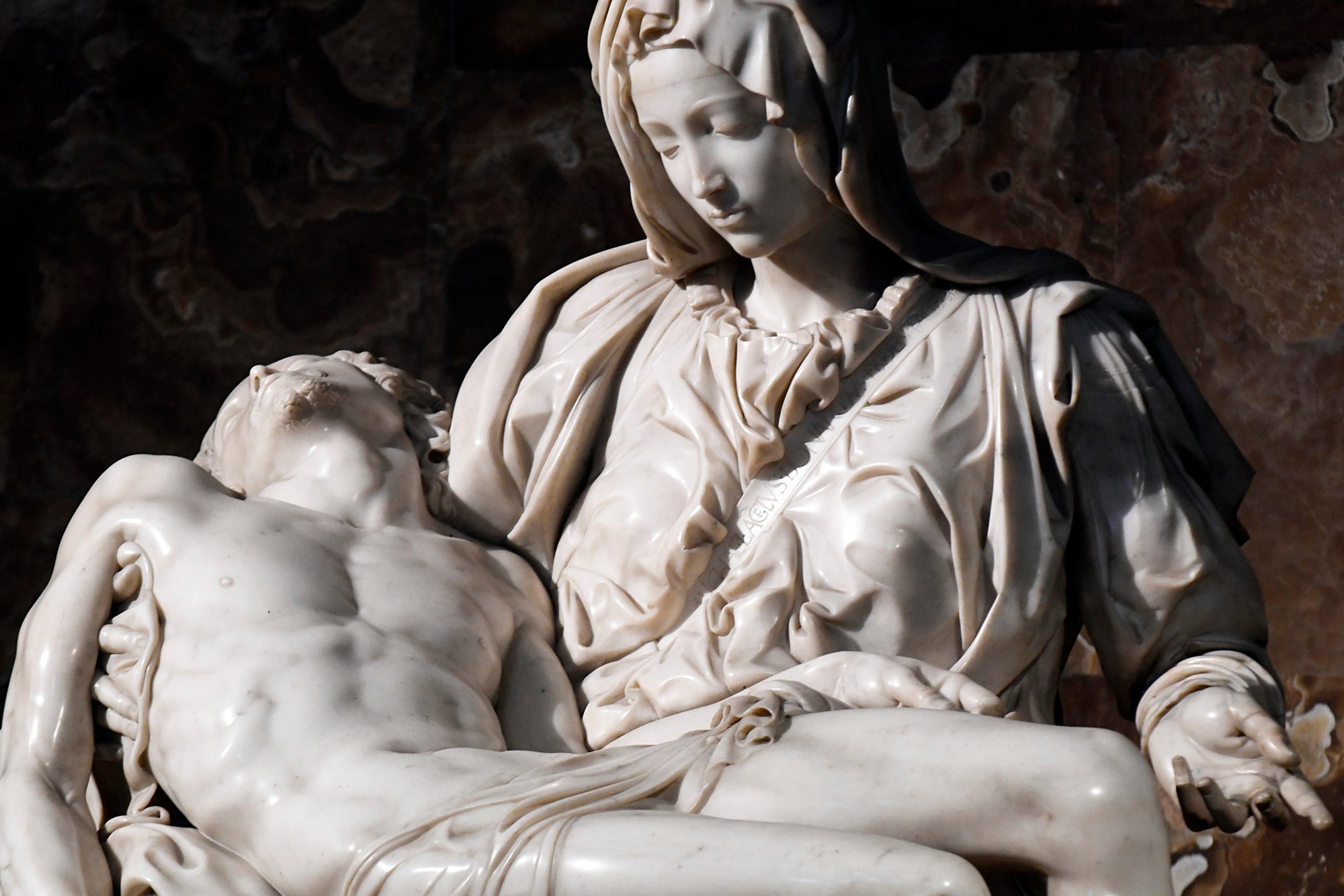MICHELANGELO'S PIETÀ: THE ENCOUNTER BETWEEN THE DIVINE AND THE HUMAN
Michelangelo Buonarroti's Pietà is undoubtedly one of the most astonishing and moving works in the history of art. More than just a sculpture, it is a profound reflection on beauty, pain, and devotion. Created by the young Florentine sculptor in 1498 when he was only 24 years old, this artwork has come to symbolize not only the pinnacle of the Renaissance but also the eternal struggle between life and death, divinity and humanity.
The story of the Pietà of the Vatican begins with a commission made by Cardinal Jean Bilhères de Lagraulas, who wanted a sculpture of the Virgin Mary holding the dead body of her son Jesus to decorate his tomb in St. Peter's Basilica. This commission, though challenging, was accepted by a Michelangelo who had already begun to establish himself as an emerging talent in the world of art. However, what would make this sculpture unique was his meticulous choice of material.
Instead of accepting any block of marble, Michelangelo personally went to the Carrara quarries, famous for their pure white marble. This marble, used by the Romans in the construction of iconic monuments, was transformed by Michelangelo into a masterpiece that would leave visitors breathless. The level of perfection he achieved in his treatment of the marble is so impressive that it is often difficult to believe the work is made of stone and not flesh and bone.
The representation of the Pietà was already a common theme in medieval sculpture, but Michelangelo moved away from the conventional depiction of a mother anguished by the death of her son. Instead of showing visceral and explicit suffering, the sculptor focused on the idealized beauty and serenity of the figures. The Virgin Mary, despite holding the dead body of Jesus, does not display heartbreaking pain; her face reflects a serene calm that contrasts with the tragedy being depicted.
In fact, Michelangelo's Pietà is a sculpture that embodies the spirit of the Renaissance: a period of revaluation of ideal beauty and human perfection. The triangular structure of the sculpture, a symbol of stability and balance, reinforces this idea of harmony that prevails over suffering. Additionally, the delicacy of the folds in the Virgin's robes and the flawless anatomy of Christ's body demonstrate Michelangelo's talent for observing and reproducing human nature with impressive precision and realism.
One aspect that has generated controversy is the youth of the Virgin Mary. Michelangelo presents her as a young woman, which caused some bewilderment at the time, as it was expected that the Virgin would be depicted as a mature woman. However, the sculptor's decision has profound symbolic meaning: Mary's youth reflects her purity and immaculate conception. It is a representation of the eternal mother, who preserves her beauty and freshness despite the pain she is experiencing.
Some biographers of the time, such as Giorgio Vasari, pointed out that the work depicted "a perfect corpse," a sculpture so detailed that it exceeded human perfection. Christ, despite being dead, seems to be in deep peace, almost as if he had been freed from earthly suffering, while the Virgin, as a mother holding the body of her son, remains calm, serene, and full of grace.
What makes this work even more unique is that it is the only sculpture Michelangelo signed. This signature, engraved on the Virgin's mantle band, became a declaration of the young sculptor's pride in response to the disbelief of those who thought such a monumental work could not have been made by such a young artist. There are various versions of how Michelangelo decided to sign it. According to some legends, after hearing that the authorship of the sculpture had been questioned, he sneaked into the Basilica one night to carve his name into the work. While some believe this was an act of humility, the truth is that his signature represents a reclamation of artistic genius and a reference to the classical tradition of Roman sculptors.
Like many other Renaissance masterpieces, Michelangelo's Pietà is not only a depiction of a religious theme but is also laden with symbolism. The figure of the Virgin Mary on a rocky pedestal evokes Mount Golgotha, the site of Christ's crucifixion, while simultaneously referencing the Vatican, the seat of the Catholic Church. Additionally, the trunk that rises at the feet of Jesus has a dual symbolic function: it not only serves as physical support for Christ's body but also represents resurrection and life after death.
Despite its serenity and perfection, the Pietà has not been exempt from tragedy. In 1972, a man attacked the sculpture with a hammer, severely damaging the Virgin's face and left hand. This act of violence, committed by a mentally disturbed man, shocked the world and sparked a debate on how to restore the work. Fortunately, the damage was repaired by restorers, and while some subtle marks remain, the sculpture returned to its original location, now better protected than ever.
The Pietà of the Vatican is just one of several that Michelangelo created throughout his life. There are two other representations of the same theme, the Pietà Bandini and the Pietà Rondinini, which, although incomplete and less known, are equally powerful depictions of suffering and human beauty.
Michelangelo's Pietà remains an eternal work, an unsurpassed example of humanity's ability to capture beauty, suffering, and spirituality in a single image. This sculpture, majestically standing in St. Peter's Basilica, continues to touch the hearts of millions of people each year, inviting them to reflect on love, sacrifice, and transcendence.











